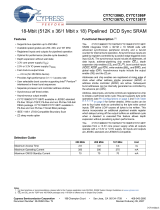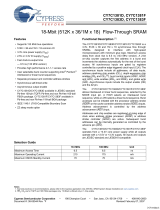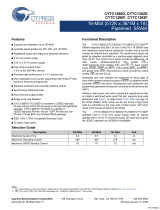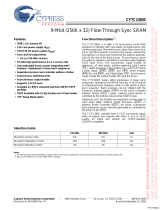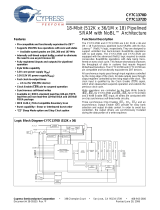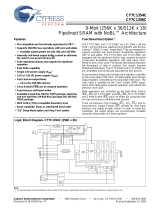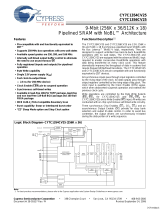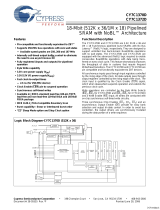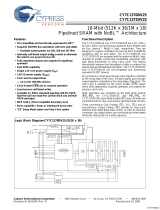Page is loading ...

CY7C1347G
4-Mbit (128K x 36) Pipelined Sync SRAM
Cypress Semiconductor Corporation • 198 Champion Court • San Jose, CA 95134-1709 • 408-943-2600
Document #: 38-05516 Rev. *F Revised January 15, 2009
Features
■ Fully registered inputs and outputs for pipelined operation
■ 128K x 36 common IO architecture
■ 3.3V core power supply (V
DD
)
■ 2.5V/3.3V IO power supply (V
DDQ
)
■ Fast clock to output times: 2.6 ns (for 250 MHz device)
■ User-selectable burst counter supporting Intel
®
Pentium
®
interleaved or linear burst sequences
■ Separate processor and controller address strobes
■ Synchronous self-timed writes
■ Asynchronous output enable
■ Offered in Pb-free 100-Pin TQFP, Pb-free and non Pb-free
119-Ball BGA package, and 165-Ball FBGA package
■ “ZZ” sleep mode option and stop clock option
■ Available in industrial and commercial temperature ranges
Functional Description
[1]
The CY7C1347G is a 3.3V, 128K x 36 synchronous-pipelined
SRAM designed to support zero-wait-state secondary cache
with minimal glue logic. CY7C1347G IO pins can operate at
either the 2.5V or the 3.3V level. The IO pins are 3.3V tolerant
when V
DDQ
= 2.5V. All synchronous inputs pass through input
registers controlled by the rising edge of the clock. All data
outputs pass through output registers controlled by the rising
edge of the clock. Maximum access delay from the clock rise is
2.6 ns (250 MHz device). CY7C1347G supports either the
interleaved burst sequence used by the Intel Pentium processor
or a linear burst sequence used by processors such as the
PowerPC
®
. The burst sequence is selected through the MODE
pin. Accesses can be initiated by asserting either the Address
Strobe from Processor (ADSP) or the Address Strobe from
Controller (ADSC
) at clock rise. Address advancement through
the burst sequence is controlled by the ADV
input. A 2-bit on-chip
wraparound burst counter captures the first address in a burst
sequence and automatically increments the address for the rest
of the burst access.
Byte write operations are qualified with the four Byte Write Select
(BW
[A:D]
) inputs. A Global Write Enable (GW) overrides all byte
write inputs and writes data to all four bytes. All writes are
conducted with on-chip synchronous self-timed write circuitry.
Three synchronous Chip Selects (CE
1
, CE
2
, CE
3
) and an
asynchronous Output Enable (OE
) provide for easy bank
selection and output tri-state control. To provide proper data
during depth expansion, OE is masked during the first clock of a
read cycle when emerging from a deselected state.
Selection Guide
Specification 250 MHz 200 MHz 166 MHz 133 MHz Unit
Maximum Access Time 2.6 2.8 3.5
4.0 ns
Maximum Operating Current 325 265 240
225 mA
Maximum CMOS Standby Current 40 40 40 40 mA
Note
1. For best practice recommendations, refer to the Cypress application note AN1064, SRAM System Guidelines.
[+] Feedback

CY7C1347G
Document #: 38-05516 Rev. *F Page 2 of 22
Block Diagram
ADDRESS
REGISTER
ADV
CLK
BURST
COUNTER
AND
LOGIC
CLR
Q1
Q0
ADSP
ADSC
MODE
BWE
GW
CE1
CE2
CE3
OE
ENABLE
REGISTER
OUTPUT
REGISTERS
SENSE
AMPS
OUTPUT
BUFFERS
E
PIPELINED
ENABLE
INPUT
REGISTERS
A0, A1, A
BW
B
BW
C
BW
D
BW
A
MEMORY
ARRAY
DQs
DQP
A
DQP
B
DQP
C
DQP
D
SLEEP
CONTROL
ZZ
A[1:0]
2
DQ
A,
DQP
A
BYTE
WRITE REGISTER
DQ
B,
DQP
B
BYTE
WRITE REGISTER
DQ
C,
DQP
C
BYTE
WRITE REGISTER
DQ
D,
DQP
D
BYTE
WRITE REGISTER
DQ
A,
DQP
A
BYTE
WRITE DRIVER
DQ
B,
DQP
B
BYTE
WRITE DRIVER
DQ
C,
DQP
C
BYTE
WRITE DRIVER
DQ
D
,DQP
D
BYTE
WRITE DRIVER
[+] Feedback

CY7C1347G
Document #: 38-05516 Rev. *F Page 3 of 22
Pinouts
A
A
A
A
A
1
A
0
NC/72M
NC/36M
V
SS
V
DD
NC/18M
NC/9M
A
A
A
A
A
A
A
DQP
B
DQ
B
DQ
B
V
DDQ
V
SSQ
DQ
B
DQ
B
DQ
B
DQ
B
V
SSQ
V
DDQ
DQ
B
DQ
B
V
SS
NC
V
DD
ZZ
DQ
A
DQ
A
V
DDQ
V
SSQ
DQ
A
DQ
A
DQ
A
DQ
A
V
SSQ
V
DDQ
DQ
A
DQ
A
DQP
A
DQP
C
DQ
C
DQ
C
V
DDQ
V
SSQ
DQ
C
DQ
C
DQ
C
DQ
C
V
SSQ
V
DDQ
DQ
C
DQ
C
NC
V
DD
NC
V
SS
DQ
D
DQ
D
V
DDQ
V
SSQ
DQ
D
DQ
D
DQ
D
DQ
D
V
SSQ
V
DDQ
DQ
D
DQ
D
DQP
D
A
A
CE
1
CE
2
BW
D
BW
C
BW
B
BW
A
CE
3
V
DD
V
SS
CLK
GW
BWE
OE
ADSC
ADSP
ADV
A
A
1
2
3
4
5
6
7
8
9
10
11
12
13
14
15
16
17
18
19
20
21
22
23
24
25
26
27
28
29
30
31
32
33
34
35
36
37
38
39
40
41
42
43
44
45
46
47
48
49
50
80
79
78
77
76
75
74
73
72
71
70
69
68
67
66
65
64
63
62
61
60
59
58
57
56
55
54
53
52
51
100
99
98
97
96
95
94
93
92
91
90
89
88
87
86
85
84
83
82
81
MODE
BYTE A
BYTE B
BYTE D
BYTE C
CY7C1347G
Figure 1. 100-Pin TQFP
[+] Feedback

CY7C1347G
Document #: 38-05516 Rev. *F Page 4 of 22
Pinouts (continued)
2
345671
A
B
C
D
E
F
G
H
J
K
L
M
N
P
R
T
U
V
DDQ
NC/288M
NC/144M
DQP
C
DQ
C
DQ
D
DQ
C
DQ
D
AA AAADSP V
DDQ
CE
2
A
DQ
C
V
DDQ
DQ
C
V
DDQ
V
DDQ
V
DDQ
DQ
D
DQ
D
NC
NC
V
DDQ
V
DD
CLK
V
DD
V
SS
V
SS
V
SS
V
SS
V
SS
V
SS
V
SS
V
SS
NC/576M
NC/1G
NC
NC
NCNCNCNC
NC/36MNC/72M
NC
V
DDQ
V
DDQ
V
DDQ
AAA
A
CE
3
AA
A
AA
A
A0
A1
DQ
A
DQ
C
DQ
A
DQ
A
DQ
A
DQ
B
DQ
B
DQ
B
DQ
B
DQ
B
DQ
B
DQ
B
DQ
A
DQ
A
DQ
A
DQ
A
DQ
B
V
DD
DQ
C
DQ
C
DQ
C
V
DD
DQ
D
DQ
D
DQ
D
DQ
D
ADSC
NC
CE
1
OE
ADV
GW
V
SS
V
SS
V
SS
V
SS
V
SS
V
SS
V
SS
V
SS
DQP
A
MODE
DQP
D
DQP
B
BW
B
BW
C
NC V
DD
NC
BW
A
NC
BWE
BW
D
ZZ
A
Figure 2. 119-Ball BGA
2345671
A
B
C
D
E
F
G
H
J
K
L
M
N
P
R
NC
NC/288M
NC/144M
DQP
C
DQ
C
DQP
D
NC
DQ
D
CE1BW
B
CE
3
BW
C
BWE
A
CE2
DQ
C
DQ
D
DQ
D
MODE
NC
DQ
C
DQ
C
DQ
D
DQ
D
DQ
D
NC/36M
NC/72M
V
DDQ
BW
D
BW
A
CLK
GW
V
SS
V
SS
V
SS
V
SS
V
DDQ
V
SS
V
DD
V
SS
V
SS
V
SS
NC/18M
V
SS
V
SS
V
SS
V
DDQ
V
DDQ
NC
V
DDQ
V
DDQ
V
DDQ
V
DDQ
A
A
V
DD
V
SS
V
DD
V
SS
V
SS
V
DDQ
V
DD
V
SS
V
DD
V
SS
V
DD
V
SS
V
SS
V
SS
V
DD
V
DD
V
SS
V
DD
V
SS
V
SS
NC
NC
V
SS
NC
A
A
DQ
C
V
SS
DQ
C
V
SS
DQ
C
DQ
C
V
SS
V
SS
V
SS
V
SS
V
SS
V
SS
V
SS
A1
DQ
D
DQ
D
NC
NC
V
DDQ
V
SS
NC
891011
NC/9M
ADV
A
ADSC
NC
OE ADSP
A
NC/576M
V
SS
V
DDQ
NC/1G DQP
B
V
DDQ
V
DD
DQ
B
DQ
B
DQ
B
NC
DQ
B
NC
DQ
A
DQ
A
V
DD
V
DDQ
V
DD
V
DDQ
DQ
B
V
DD
NC
V
DD
DQ
A
V
DD
V
DDQ
DQ
A
V
DDQ
V
DD
V
DD
V
DDQ
V
DD
V
DDQ
DQ
A
V
DDQ
AA
V
SS
A
A
A
DQ
B
DQ
B
DQ
B
ZZ
DQ
A
DQ
A
DQP
A
DQ
A
A
V
DDQ
A
A0
A
V
SS
Figure 3. 165-Ball FBGA
[+] Feedback

CY7C1347G
Document #: 38-05516 Rev. *F Page 5 of 22
Table 1. Pin Definitions
Name IO Description
A
0
,A
1
,A Input-
Synchronous
Address Inputs Used to Select One of the 128K Address Locations. Sampled at the rising edge
of the CLK if ADSP
or ADSC is active LOW, and CE
1
,
CE
2
, and
CE
3
are sampled active. A
[1:0]
feeds
the 2-bit counter.
BW
A,
BW
B,
BW
C,
BW
D
Input-
Synchronous
Byte Write Select Inputs, Active LOW. Qualified with BWE to conduct byte writes to the SRAM.
Sampled on the rising edge of CLK.
GW Input-
Synchronous
Global Write Enable Input, Active LOW. When asserted LOW on the rising edge of CLK, a global
write is conducted (ALL bytes are written, regardless of the values on BW
[A:D]
and BWE).
BWE Input-
Synchronous
Byte Write Enable Input, Active LOW. Sampled on the rising edge of CLK. This signal must be
asserted LOW to conduct a byte write.
CLK Input-Clock Clock Input. Used to capture all synchronous inputs to the device. Also used to increment the burst
counter when ADV
is asserted LOW, during a burst operation.
CE
1
Input-
Synchronous
Chip Enable 1 Input, Active LOW. Sampled on the rising edge of CLK. Used in conjunction with CE
2
and CE
3
to select or deselect the device. ADSP is ignored if CE
1
is HIGH. CE
1
is sampled only when
a new external address is loaded.
CE
2
Input-
Synchronous
Chip Enable 2 Input, Active HIGH. Sampled on the rising edge of CLK. Used in conjunction with CE
1
and CE
3
to select or deselect the device. CE
2
is sampled only when a new external address is loaded.
CE
3
Input-
Synchronous
Chip Enable 3 Input, Active LOW. Sampled on the rising edge of CLK. Used in conjunction with CE
1
and
CE
2
to select or deselect the device. CE
3
is sampled only when a new external address is loaded.
OE Input-
Asynchronous
Output Enable, Asynchronous Input, Active LOW. Controls the direction of the IO pins. When LOW,
the IO pins behave as outputs. When deasserted HIGH, IO pins are tri-stated, and act as input data
pins. OE
is masked during the first clock of a read cycle when emerging from a deselected state.
ADV Input-
Synchronous
Advance Input Signal, Sampled on the Rising Edge of CLK. When asserted, it automatically
increments the address in a burst cycle.
ADSP Input-
Synchronous
Address Strobe from Processor, Sampled on the Rising Edge of CLK. When asserted LOW,
addresses presented to the device are captured in the address registers. A
[1:0]
are also loaded into the
burst counter. When ADSP
and ADSC are both asserted, only ADSP is recognized. ASDP is ignored
when CE
1
is deasserted HIGH.
ADSC Input-
Synchronous
Address Strobe from Controller, Sampled on the Rising Edge of CLK. When asserted LOW,
addresses presented to the device are captured in the address registers. A
[1:0]
are also loaded into the
burst counter. When ADSP
and ADSC are both asserted, only ADSP is recognized.
ZZ Input-
Asynchronous
ZZ “Sleep” Input. This active HIGH input places the device in a non-time-critical “sleep” condition with
data integrity preserved. During normal operation, this pin must be LOW or left floating. ZZ pin has an
internal pull down.
DQ
A,
DQ
B
DQ
C,
DQ
D
DQP
A,
DQP
B,
DQP
C,
DQP
D
IO-
Synchronous
Bidirectional Data IO Lines. As inputs, they feed into an on-chip data register that is triggered by the
rising edge of CLK. As outputs, they deliver the data contained in the memory location specified by the
addresses presented during the previous clock rise of the read cycle. The direction of the pins is
controlled by OE
. When OE is asserted LOW, the pins behave as outputs. When HIGH, DQs and DQPs
are placed in a tri-state condition.
V
DD
Power Supply Power Supply Inputs to the Core of the Device
V
SS
Ground Ground for the Core of the Device
V
DDQ
IO Power Supply Power Supply for the IO circuitry
V
SSQ
IO Ground Ground for the IO circuitry
MODE Input-
Static
Selects Burst Order. When tied to GND selects linear burst sequence. When tied to V
DDQ
or left
floating selects interleaved burst sequence. This is a strap pin and must remain static during device
operation. Mode pin has an internal pull up.
NC, NC/9M,
NC/18M,
NC/36M,
NC/72M,
NC/144M,
NC/288M,
NC/576M,
NC/1G
– No Connects. Not internally connected to the die. NC/9M, NC/18M, NC/36M, NC/72M, NC/144M,
NC/288M, NC/576M, and NC/1G are address expansion pins that are not internally connected to the
die.
[+] Feedback

CY7C1347G
Document #: 38-05516 Rev. *F Page 6 of 22
Functional Overview
All synchronous inputs pass through input registers controlled by
the rising edge of the clock. All data outputs pass through output
registers controlled by the rising edge of the clock. Maximum
access delay from the clock rise (t
CO
) is 2.6 ns (250 MHz device).
The CY7C1347G supports secondary cache in systems using
either a linear or interleaved burst sequence. The linear burst
sequence is suited for processors that use a linear burst
sequence. The burst order is user selectable, and is determined
by sampling the MODE input. Accesses can be initiated with
either the Address Strobe from Processor (ADSP
) or the Address
Strobe from Controller (ADSC
). Address advancement through
the burst sequence is controlled by the ADV
input. A two-bit
on-chip wraparound burst counter captures the first address in a
burst sequence and automatically increments the address for the
rest of the burst access.
Byte write operations are qualified with the Byte Write Enable
(BWE
) and Byte Write Select (BW
[A:D]
) inputs. A Global Write
Enable (GW
) overrides all byte write inputs and writes data to all
four bytes. All writes are simplified with on-chip synchronous
self-timed write circuitry.
Three synchronous Chip Selects (CE
1
, CE
2
, CE
3
) and an
asynchronous Output Enable (OE
) provide for easy bank
selection and output tri-state control. ADSP
is ignored if CE
1
is
HIGH.
Single Read Accesses
This access is initiated when the following conditions are
satisfied at clock rise: (1) ADSP
or ADSC is asserted LOW, (2)
CE
1
, CE
2
, CE
3
are all asserted active, and (3) the write signals
(GW
, BWE) are all deasserted HIGH. ADSP is ignored if CE
1
is
HIGH. The address presented to the address inputs (A
[16:0]
) is
stored into the address advancement logic and the Address
Register while being presented to the memory core. The corre-
sponding data is allowed to propagate to the input of the Output
Registers. At the rising edge of the next clock the data is allowed
to propagate through the Output Register and onto the data bus
within 2.6 ns (250 MHz device) if OE
is active LOW. The only
exception occurs when the SRAM is emerging from a deselected
state to a selected state, its outputs are always tri-stated during
the first cycle of the access. After the first cycle of the access,
the outputs are controlled by the OE
signal. Consecutive single
read cycles are supported. After the SRAM is deselected at clock
rise by the chip select and either ADSP
or ADSC signals, its
output tri-states immediately.
Single Write Accesses Initiated by ADSP
This access is initiated when both of the following conditions are
satisfied at clock rise: (1) ADSP
is asserted LOW, and (2) CE
1
,
CE
2
, CE
3
are all asserted active. The address presented to
A
[16:0]
is loaded into the Address Register and the address
advancement logic while being delivered to the RAM core. The
write signals (GW
, BWE, and BW
[A:D]
) and ADV inputs are
ignored during this first cycle.
ADSP
-triggered write accesses require two clock cycles to
complete. If GW
is asserted LOW on the second clock rise, the
data presented to the DQs and DQPs inputs is written into the
corresponding address location in the RAM core. If GW
is HIGH,
then the write operation is controlled by BWE
and BW
[A:D]
signals. The CY7C1347G provides byte write capability that is
described in Table 6 on page 8. Asserting the Byte Write Enable
input (BWE
) with the selected Byte Write (BW
[A:D]
) input selec-
tively writes to only the desired bytes.
Bytes not selected during a byte write operation remain
unaltered. A synchronous self-timed write mechanism is
provided to simplify the write operations.
Because the CY7C1347G is a common IO device, the Output
Enable (OE
) must be deasserted HIGH before presenting data
to the DQs and DQPs inputs. Doing so tri-states the output
drivers. As a safety precaution, DQs and DQPs are automatically
tri-stated whenever a write cycle is detected, regardless of the
state of OE
.
Single Write Accesses Initiated by ADSC
ADSC write accesses are initiated when the following conditions
are satisfied: (1) ADSC
is asserted LOW, (2) ADSP is deasserted
HIGH, (3) CE
1
, CE
2
, CE
3
are all asserted active, and (4) the
appropriate combination of the write inputs (GW
, BWE, and
BW
[A:D]
) are asserted active to conduct a write to the desired
byte(s). ADSC
-triggered write accesses require a single clock
cycle to complete. The address presented to A
[16:0]
is loaded into
the address register and the address advancement logic while
being delivered to the RAM core. The ADV input is ignored
during this cycle. If a global write is conducted, the data
presented to the DQs and DQPs is written into the corresponding
address location in the RAM core. If a byte write is conducted,
only the selected bytes are written. Bytes not selected during a
byte write operation remain unaltered. A synchronous self-timed
write mechanism has been provided to simplify the write opera-
tions.
Because the CY7C1347G is a common IO device, the Output
Enable (OE
) must be deasserted HIGH before presenting data
to the DQs and DQPs inputs. Doing so tri-states the output
drivers. As a safety precaution, DQs and DQPs are automatically
tri-stated whenever a write cycle is detected, regardless of the
state of OE.
Burst Sequences
The CY7C1347G provides a two-bit wraparound counter, fed by
A
[1:0]
, that implements either an interleaved or linear burst
sequence. The interleaved burst sequence is designed
specifically to support Intel Pentium applications. The linear
burst sequence is designed to support processors that follow a
linear burst sequence. The burst sequence is user-selectable
through the MODE input.
Asserting ADV
LOW at clock rise automatically increments the
burst counter to the next address in the burst sequence. Both
read and write burst operations are supported.
Sleep Mode
The ZZ input pin is an asynchronous input. Asserting ZZ places
the SRAM in a power conservation “sleep” mode. Two clock
cycles are required to enter into or exit from this “sleep” mode.
While in this mode, data integrity is guaranteed. Accesses
pending when entering the “sleep” mode are not considered valid
nor is the completion of the operation guaranteed. The device
must be deselected before entering the “sleep” mode. CE
1
, CE
2
,
CE
3
, ADSP, and ADSC must remain inactive for the duration of
t
ZZREC
after the ZZ input returns LOW.
[+] Feedback

CY7C1347G
Document #: 38-05516 Rev. *F Page 7 of 22
Table 2. Interleaved Burst Sequence
First
Address
Second
Address
Third
Address
Fourth
Address
A
[1:0]
A
[1:0]
A
[1:0]
A
[1:0]
00 01 10 11
01 00 11 10
10 11 00 01
11 10 01 00
Table 3. Linear Burst Sequence
First
Address
Second
Address
Third
Address
Fourth
Address
A
[1:0]
A
[1:0]
A
[1:0]
A
[1:0]
00 01 10 11
01 10 11 00
10 11 00 01
11 00 01 10
Table 4. ZZ Mode Electrical Characteristics
Parameter Description Test Conditions Min Max Unit
I
DDZZ
Snooze mode standby current ZZ > V
DD
− 0.2V 40 mA
t
ZZS
Device operation to ZZ ZZ > V
DD
− 0.2V 2t
CYC
ns
t
ZZREC
ZZ recovery time ZZ < 0.2V 2t
CYC
ns
t
ZZI
ZZ Active to snooze current This parameter is sampled 2t
CYC
ns
t
RZZI
ZZ Inactive to exit snooze current This parameter is sampled 0 ns
Table 5. Truth Table
[2, 3, 4, 5, 6]
Next Cycle
Add.
Used
CE
1
CE
2
CE
3
ZZ ADSP ADSC ADV WRITE OE CLK DQ
Deselect Cycle, Power Down None H X X L X L X X X L-H Tri-State
Deselect Cycle, Power Down None L L X L L X X X X L-H Tri-State
Deselect Cycle, Power Down None L X H L L X X X X L-H Tri-State
Deselect Cycle, Power Down None L L X L H L X X X L-H Tri-State
Deselect Cycle, Power Down None L X H L H L X X X L-H Tri-State
Snooze Mode, Power Down None X X X H X X X X X X Tri-State
Read Cycle, Begin Burst External L H L L L X X X L L-H Q
Read Cycle, Begin Burst External L H L L L X X X H L-H Tri-State
Write Cycle, Begin Burst External L H L L H L X L X L-H D
Read Cycle, Begin Burst External L H L L H L X H L L-H Q
Read Cycle, Begin Burst External L H L L H L X H H L-H Tri-State
Read Cycle, Continue Burst Next X X X L H H L H H L-H Tri-State
Read Cycle, Continue Burst Next X X X L H H L H L L-H Q
Read Cycle, Continue Burst Next H X X L X H L H L L-H Q
Read Cycle, Continue Burst Next H X X L X H L H H L-H Tri-State
Note
2. X = “Do Not Care.” H = Logic HIGH, L = Logic LOW.
3. WRITE
= L when any one or more Byte Write Enable signals (BW
A
, BW
B
, BW
C
, BW
D
) and BWE = L or GW = L. WRITE = H when all Byte Write Enable signals (BW
A
,
BW
B
, BW
C
, BW
D
), BWE, GW = H.
4. The DQ pins are controlled by the current cycle and the OE
signal. OE is asynchronous and is not sampled with the clock.
5. The SRAM always initiates a read cycle when ADSP
is asserted, regardless of the state of GW, BWE, or BW
[A:D]
. Writes may occur only on subsequent clocks after
the ADSP
or with the assertion of ADSC. As a result, OE must be driven HIGH before the start of the write cycle to allow the outputs to tri-state. OE is a don't care for
the remainder of the write cycle.
6. OE
is asynchronous and is not sampled with the clock rise. It is masked internally during write cycles. During a read cycle all data bits are tri-state when OE is inactive
or when the device is deselected, and all data bits behave as output when OE
is active (LOW).
[+] Feedback

CY7C1347G
Document #: 38-05516 Rev. *F Page 8 of 22
Write Cycle, Continue Burst Next X X X L H H L L X L-H D
Write Cycle, Continue Burst Next H X X L X H L L X L-H D
Read Cycle, Suspend Burst Current X X X L H H H H L L-H Q
Read Cycle, Suspend Burst Current X X X L H H H H H L-H Tri-State
Read Cycle, Suspend Burst Current H X X L X H H H L L-H Q
Read Cycle, Suspend Burst Current H X X L X H H H H L-H Tri-State
Write Cycle, Suspend Burst Current X X X L H H H L X L-H D
Write Cycle, Suspend Burst Current H X X L X H H L X L-H D
Table 5. Truth Table
[2, 3, 4, 5, 6]
(continued)
Next Cycle
Add.
Used
CE
1
CE
2
CE
3
ZZ ADSP ADSC ADV WRITE OE CLK DQ
Table 6. Partial Truth Table for Read/Write
[2, 7]
Function GW BWE BW
D
BW
C
BW
B
BW
A
Read H H X X X X
Read H L H H H H
Write Byte A – DQ
A
HLH HHL
Write Byte B – DQ
B
HLH HLH
Write Bytes B, A H L H H L L
Write Byte C– DQ
C
HLH LHH
Write Bytes C, A H L H L H L
Write Bytes C, B H L H L L H
Write Bytes C, B, A H L H L L L
Write Byte D– DQ
D
HLL HHH
Write Bytes D, A H L L H H L
Write Bytes D, B H L L H L H
Write Bytes D, B, A H L L H L L
Write Bytes D, C H L L L H H
Write Bytes D, C, A H L L L H L
Write Bytes D, C, B H L L L L H
Write All Bytes H L L L L L
Write All Bytes L X X X X X
Note
7. This table is only a partial listing of the byte write combinations. Any combination of BW
x
is valid. Appropriate write is based on which byte write is active.
[+] Feedback

CY7C1347G
Document #: 38-05516 Rev. *F Page 9 of 22
Maximum Ratings
Exceeding the maximum ratings may shorten the battery life of
the device. User guidelines are not tested.
Storage Temperature ..................................... −65°C to +150°C
Ambient Temperature with
Power Applied.................................................. −55°C to +125°C
Supply Voltage on V
DD
Relative to GND.........−0.5V to +4.6V
Supply Voltage on V
DDQ
Relative to GND........−0.5V to +V
DD
DC Voltage Applied to Outputs
in High-Z State........................................... −0.5V to V
DD
+ 0.5V
DC Input Voltage ....................................... −0.5V to V
DD
+ 0.5V
Current into Outputs (LOW).........................................20 mA
Static Discharge Voltage.......................................... > 2001V
(MIL-STD-883, Method 3015)
Latch-Up Current................................................... > 200 mA
Operating Range
Range
Ambient
Temperature
V
DD
V
DDQ
Commercial 0°C to +70°C 3.3V
−5%/+10%
2.5V −5%
to V
DD
Industrial –40°C to +85°C
Electrical Characteristics
Over the Operating Range
[8, 9]
Parameter Description Test Conditions Min Max Unit
V
DD
Power Supply Voltage 3.135 3.6 V
V
DDQ
IO Supply Voltage 2.375 V
DD
V
V
OH
Output HIGH Voltage For 3.3V IO, I
OH
= –4.0 mA 2.4 V
For 2.5V IO, I
OH
= –1.0 mA 2.0 V
V
OL
Output LOW Voltage For 3.3V IO, I
OL
= 8.0 mA 0.4 V
For 2.5V IO, I
OL
= 1.0 mA 0.4 V
V
IH
Input HIGH Voltage
[8]
For 3.3V IO 2.0 V
DD
+ 0.3V V
For 2.5V IO 1.7 V
DD
+ 0.3V V
V
IL
Input LOW Voltage
[8]
For 3.3V IO –0.3 0.8 V
For 2.5V IO –0.3 0.7 V
I
X
Input Leakage Current
Except ZZ and MODE
GND < V
I
< V
DDQ
−55μA
Input Current of MODE Input = V
SS
−30 μA
Input = V
DD
5 μA
Input Current of ZZ Input = V
SS
−5 μA
Input = V
DD
30 μA
I
OZ
Output Leakage Current GND ≤ V
I
≤ V
DDQ,
Output Disabled −55μA
I
DD
V
DD
Operating Supply
Current
V
DD
= Max., I
OUT
= 0 mA,
f = f
MAX
= 1/t
CYC
4 ns cycle, 250 MHz 325 mA
5 ns cycle, 200 MHz 265 mA
6 ns cycle, 166 MHz 240 mA
7.5 ns cycle, 133 MHz 225 mA
I
SB1
Automatic CE
Power Down
Current—TTL Inputs
Max. V
DD
, Device Deselected,
V
IN
> V
IH
or V
IN
< V
IL
f = f
MAX
= 1/t
CYC
4 ns cycle, 250 MHz 120 mA
5 ns cycle, 200 MHz 110 mA
6 ns cycle, 166 MHz 100 mA
7.5 ns cycle, 133 MHz 90 mA
I
SB2
Automatic CE
Power Down
Current—CMOS Inputs
Max. V
DD
, Device Deselected,
V
IN
< 0.3V or V
IN
> V
DDQ
– 0.3V,
f = 0
All speeds 40 mA
Notes
8. Overshoot: V
IH
(AC) < V
DD
+1.5V (pulse width less than t
CYC
/2). Undershoot: V
IL
(AC) > –2V (pulse width less than t
CYC
/2).
9. T
Power up
: assumes a linear ramp from 0V to V
DD
(min) within 200 ms. During this time V
IH
< V
DD
and V
DDQ
< V
DD
.
[+] Feedback

CY7C1347G
Document #: 38-05516 Rev. *F Page 10 of 22
I
SB3
Automatic CE
Power Down
Current—CMOS Inputs
Max. V
DD
, Device Deselected, or
V
IN
< 0.3V or V
IN
> V
DDQ
– 0.3V
f = f
MAX
= 1/t
CYC
4 ns cycle, 250 MHz 105 mA
5 ns cycle, 200 MHz 95 mA
6 ns cycle, 166 MHz 85 mA
7.5 ns cycle, 133 MHz 75 mA
I
SB4
Automatic CE
Power Down
Current—TTL Inputs
Max. V
DD
, Device Deselected,
V
IN
≥ V
IH
or V
IN
≤ V
IL
, f = 0
45 mA
Electrical Characteristics (continued)
Over the Operating Range
[8, 9]
Parameter Description Test Conditions Min Max Unit
Capacitance
Tested initially and after any design or process changes that may affect these parameters.
Parameter Description Test Conditions
100 TQFP
Max
119 BGA
Max
165 FBGA
Max
Unit
C
IN
Input Capacitance T
A
= 25°C, f = 1 MHz,
V
DD
= 3.3V.
V
DDQ
= 3.3V
555pF
C
CLK
Clock Input Capacitance 5 5 5 pF
C
IO
Input/Output Capacitance 5 7 7 pF
Thermal Resistance
Tested initially and after any design or process changes that may affect these parameters.
Parameter Description Test Conditions
100 TQFP
Package
119 BGA
Package
165 FBGA
Package
Unit
Θ
JA
Thermal Resistance
(Junction to Ambient)
Test conditions follow standard
test methods and procedures for
measuring thermal impedance,
per EIA/JESD51.
30.32 34.1 20.3 °C/W
Θ
JC
Thermal Resistance
(Junction to Case)
6.85 14.0 4.6 °C/W
AC Test Loads and Waveforms
Figure 4. AC Test Loads and Waveforms
OUTPUT
R = 317Ω
R = 351Ω
5pF
INCLUDING
JIG AND
SCOPE
(a)
(b)
OUTPUT
R
L
= 50Ω
Z
0
= 50Ω
3.3V
ALL INPUT PULSES
V
DDQ
GND
90%
10%
90%
10%
≤ 1 ns
≤ 1 ns
(c)
OUTPUT
R = 1667Ω
R = 1538Ω
5pF
INCLUDING
JIG AND
SCOPE
(a)
(b)
OUTPUT
R
L
= 50Ω
Z
0
= 50Ω
V
T
= 1.25V
2.5V
ALL INPUT PULSES
V
DDQ
GND
90%
10%
90%
10%
≤ 1 ns
≤ 1 ns
(c)
3.3V IO Test Load
2.5V IO Test Load
V
T
= 1.5V
[+] Feedback

CY7C1347G
Document #: 38-05516 Rev. *F Page 11 of 22
Switching Characteristics
Over the Operating Range
[14, 15]
Parameter Description
–250 –200 –166 –133
Unit
Min Max Min Max Min Max Min Max
t
POWER
V
DD
(Typical) to the first Access
[10]
1111ms
Clock
t
CYC
Clock Cycle Time 4.0 5.0 6.0 7.5 ns
t
CH
Clock HIGH 1.7 2.0 2.5 3.0 ns
t
CL
Clock LOW 1.7 2.0 2.5 3.0 ns
Output Times
t
CO
Data Output Valid After CLK Rise 2.6 2.8 3.5 4.0 ns
t
DOH
Data Output Hold After CLK Rise 1.0 1.0 1.5 1.5 ns
t
CLZ
Clock to Low-Z
[11, 12, 13]
0000ns
t
CHZ
Clock to High-Z
[11, 12, 13]
2.6 2.8 3.5 4.0 ns
t
OEV
OE LOW to Output Valid
2.6 2.8 3.5 4.5 ns
t
OELZ
OE LOW to Output Low-Z
[11, 12, 13]
0000ns
t
OEHZ
OE HIGH to Output High-Z
[11, 12, 13]
2.6 2.8 3.5 4.0 ns
Setup Times
t
AS
Address Setup Before CLK Rise 1.2 1.2 1.5 1.5 ns
t
ADS
ADSC, ADSP Setup Before CLK Rise
1.2 1.2 1.5 1.5 ns
t
ADVS
ADV Setup Before CLK Rise
1.2 1.2 1.5 1.5 ns
t
WES
GW, BWE, BW
X
Setup Before CLK Rise
1.2 1.2 1.5 1.5 ns
t
DS
Data Input Setup Before CLK Rise 1.2 1.2 1.5 1.5 ns
t
CES
Chip Enable Setup Before CLK Rise 1.2 1.2 1.5 1.5 ns
Hold Times
t
AH
Address Hold After CLK Rise 0.3 0.5 0.5 0.5 ns
t
ADH
ADSP, ADSC Hold After CLK Rise
0.3 0.5 0.5 0.5 ns
t
ADVH
ADV Hold After CLK Rise
0.3 0.5 0.5 0.5 ns
t
WEH
GW, BWE, BW
X
Hold After CLK Rise
0.3 0.5 0.5 0.5 ns
t
DH
Data Input Hold After CLK Rise 0.3 0.5 0.5 0.5 ns
t
CEH
Chip Enable Hold After CLK Rise 0.3 0.5 0.5 0.5 ns
Notes
10.This part has an internal voltage regulator; t
POWER
is the time that the power must be supplied above V
DD
(min) initially before a read or write operation can be initiated.
11. t
CHZ
, t
CLZ
, t
OELZ
, and t
OEHZ
are specified with AC test conditions shown in part (b) of AC Test Loads and Waveforms on page 10. Transition is measured ±200 mV
from steady-state voltage.
12.At any voltage and temperature, t
OEHZ
is less than t
OELZ
and t
CHZ
is less than t
CLZ
to eliminate bus contention between SRAMs when sharing the same data bus.
These specifications do not imply a bus contention condition, but reflect parameters guaranteed over worst case user conditions. Device is designed to achieve High-Z
before Low-Z under the same system conditions.
13.This parameter is sampled and not 100% tested.
14.Timing references level is 1.5V when V
DDQ
= 3.3V and is 1.25V when V
DDQ
= 2.5V on all data sheets.
15.Test conditions shown in (a) of AC Test Loads and Waveforms on page 10 unless otherwise noted.
[+] Feedback

CY7C1347G
Document #: 38-05516 Rev. *F Page 12 of 22
Switching Waveforms
Figure 5. Read Cycle Timing
[16]
t
CYC
t
CL
CLK
ADSP
t
ADH
t
ADS
ADDRESS
t
CH
OE
ADSC
CE
t
AH
t
AS
A1
t
CEH
t
CES
GW, BWE,
BW
[A:D]
D
ata Out (Q)
High-Z
t
CLZ
t
DOH
t
CO
ADV
t
OEHZ
t
CO
Single READ BURST READ
t
OEV
t
OELZ
t
CHZ
ADV
suspends
burst.
Burst wraps around
to its initial state
t
ADVH
t
ADVS
t
WEH
t
WES
t
ADH
t
ADS
Q(A2) Q(A2 + 1) Q(A2 + 2)
Q(A1)
Q(A2) Q(A2 + 1)Q(A2 + 3)
A2 A3
Deselect
cycle
Burst continued with
new base address
DON’T CARE
UNDEFINED
Note
16.In this diagram, when CE
is LOW, CE
1
is LOW, CE
2
is HIGH, and CE
3
is LOW. When CE is HIGH, CE
1
is HIGH, CE
2
is LOW, or CE
3
is HIGH.
[+] Feedback

CY7C1347G
Document #: 38-05516 Rev. *F Page 13 of 22
Figure 6. Write Cycle Timing
[16, 17]
Switching Waveforms (continued)
t
CYC
t
CL
CLK
ADSP
t
ADH
t
ADS
ADDRESS
t
CH
OE
ADSC
CE
t
AH
t
AS
A1
t
CEH
t
CES
BWE,
BW[A :B]
D
ata Out (Q)
High-Z
ADV
BURST READ BURST WRITE
D(A2) D(A2 + 1) D(A2 + 1)
D(A1)
D(A3) D(A3 + 1) D(A3 + 2)D(A2 + 3)
A2 A3
Data In (D)
Extended BURST WRITE
D(A2 + 2)
Single WRITE
t
ADH
t
ADS
t
ADH
t
ADS
t
OEHZ
t
ADVH
t
ADVS
t
WEH
t
WES
t
DH
t
DS
GW
t
WEH
t
WES
Byte write signals are
ignored for rst cycle when
ADSP initiates burst
ADSC extends burst
ADV suspends burst
DON’T CARE
UNDEFINED
Note
17.Full width write can be initiated by either GW
LOW, or by GW HIGH, BWE LOW, and BW
x
LOW.
[+] Feedback

CY7C1347G
Document #: 38-05516 Rev. *F Page 14 of 22
Figure 7. Read/Write Cycle Timing
[16, 18, 19]
Switching Waveforms (continued)
t
CYC
t
CL
CLK
ADSP
t
ADH
t
ADS
ADDRESS
t
CH
OE
ADSC
CE
t
AH
t
AS
A2
t
CEH
t
CES
BWE,
BW[A:D]
D
ata Out (Q)
High-Z
ADV
Single WRITE
D(A3)
A4 A5 A6
D(A5) D(A6)
Data In (D)
BURST READBack-to-Back READs
High-Z
Q(A2)Q(A1)
Q(A4) Q(A4+1) Q(A4+2)
t
WEH
t
WES
Q(A4+3)
t
OEHZ
t
DH
t
DS
t
OELZ
t
CLZ
t
CO
Back-to-Back
WRITEs
A1
DON’T CARE UNDEFINED
A3
Notes
18.The data bus (Q) remains in High-Z following a write cycle, unless a new read access is initiated by ADSP
or ADSC.
19.GW
is HIGH.
[+] Feedback

CY7C1347G
Document #: 38-05516 Rev. *F Page 15 of 22
Figure 8. ZZ Mode Timing
[20, 21]
Switching Waveforms (continued)
t
ZZ
I
SUPPLY
CLK
ZZ
t
ZZREC
A
LL INPUTS
(except ZZ)
DON’T CARE
I
DDZZ
t
ZZI
t
RZZI
Outputs (Q)
High-Z
DESELECT or READ Only
Notes
20.Device must be deselected when entering ZZ mode. See Table 5 on page 7 for all possible signal conditions to deselect the device.
21.DQs are in high-Z when exiting ZZ sleep mode.
[+] Feedback

CY7C1347G
Document #: 38-05516 Rev. *F Page 16 of 22
Ordering Information
The following table lists all possible speed, package and temperature range options supported for these devices. Note that some
options listed may not be available for order entry. To verify the availability of a specific option, visit the Cypress website at
www.cypress.com and refer to the product summary page at http://www.cypress.com/products or contact your local sales
representative for the status of availability of parts.
Cypress maintains a worldwide network of offices, solution centers, manufacturer’s representatives and distributors. To find the office
closest to you, visit us at http://app.cypress.com/portal/server.pt?space=CommunityPage&control=SetCommunity&CommunityID=
201&PageID=230.
Table 7. Ordering Information
Speed
(MHz)
Ordering Code
Package
Diagram
Package Type
Operating
Range
133 CY7C1347G-133AXC 51-85050 100-Pin Thin Quad Flat Pack (14 x 20 x 1.4 mm) Pb-Free Commercial
CY7C1347G-133BGC 51-85115 119-Ball Ball Grid Array (14 x 22 x 2.4 mm)
CY7C1347G-133BGXC 119-Ball Ball Grid Array (14 x 22 x 2.4 mm) Pb-Free
CY7C1347G-133BZC 51-85180 165-Ball Fine-Pitch Ball Grid Array (13 x 15 x 1.4 mm)
CY7C1347G-133BZXC 165-Ball Fine-Pitch Ball Grid Array (13 x 15 x 1.4 mm) Pb-Free
CY7C1347G-133AXI 51-85050 100-Pin Thin Quad Flat Pack (14 x 20 x 1.4 mm) Pb-Free Industrial
CY7C1347G-133BGI 51-85115 119-Ball Ball Grid Array (14 x 22 x 2.4 mm)
CY7C1347G-133BGXI 119-Ball Ball Grid Array (14 x 22 x 2.4 mm) Pb-Free
CY7C1347G-133BZI 51-85180 165-Ball Fine-Pitch Ball Grid Array (13 x 15 x 1.4 mm)
CY7C1347G-133BZXI 165-Ball Fine-Pitch Ball Grid Array (13 x 15 x 1.4 mm) Pb-Free
166 CY7C1347G-166AXC 51-85050 100-Pin Thin Quad Flat Pack (14 x 20 x 1.4 mm) Pb-Free Commercial
CY7C1347G-166BGC 51-85115 119-Ball Ball Grid Array (14 x 22 x 2.4 mm)
CY7C1347G-166BGXC 119-Ball Ball Grid Array (14 x 22 x 2.4 mm) Pb-Free
CY7C1347G-166BZC 51-85180 165-Ball Fine-Pitch Ball Grid Array (13 x 15 x 1.4 mm)
CY7C1347G-166BZXC 165-Ball Fine-Pitch Ball Grid Array (13 x 15 x 1.4 mm) Pb-Free
CY7C1347G-166AXI 51-85050 100-Pin Thin Quad Flat Pack (14 x 20 x 1.4 mm) Pb-Free Industrial
CY7C1347G-166BGI 51-85115 119-Ball Ball Grid Array (14 x 22 x 2.4 mm)
CY7C1347G-166BGXI 119-Ball Ball Grid Array (14 x 22 x 2.4 mm) Pb-Free
CY7C1347G-166BZI 51-85180 165-Ball Fine-Pitch Ball Grid Array (13 x 15 x 1.4 mm)
CY7C1347G-166BZXI 165-Ball Fine-Pitch Ball Grid Array (13 x 15 x 1.4 mm) Pb-Free
200 CY7C1347G-200AXC 51-85050 100-Pin Thin Quad Flat Pack (14 x 20 x 1.4 mm) Pb-Free Commercial
CY7C1347G-200BGC 51-85115 119-Ball Ball Grid Array (14 x 22 x 2.4 mm)
CY7C1347G-200BGXC 119-Ball Ball Grid Array (14 x 22 x 2.4 mm) Pb-Free
CY7C1347G-200BZC 51-85180 165-Ball Fine-Pitch Ball Grid Array (13 x 15 x 1.4 mm)
CY7C1347G-200BZXC 165-Ball Fine-Pitch Ball Grid Array (13 x 15 x 1.4 mm) Pb-Free
CY7C1347G-200AXI 51-85050 100-Pin Thin Quad Flat Pack (14 x 20 x 1.4 mm) Pb-Free Industrial
CY7C1347G-200BGI 51-85115 119-Ball Ball Grid Array (14 x 22 x 2.4 mm)
CY7C1347G-200BGXI 119-Ball Ball Grid Array (14 x 22 x 2.4 mm) Pb-Free
CY7C1347G-200BZI 51-85180 165-Ball Fine-Pitch Ball Grid Array (13 x 15 x 1.4 mm)
CY7C1347G-200BZXI 165-Ball Fine-Pitch Ball Grid Array (13 x 15 x 1.4 mm) Pb-Free
[+] Feedback

CY7C1347G
Document #: 38-05516 Rev. *F Page 17 of 22
250 CY7C1347G-250AXC 51-85050 100-Pin Thin Quad Flat Pack (14 x 20 x 1.4 mm) Pb-Free Commercial
CY7C1347G-250BGC 51-85115 119-Ball Ball Grid Array (14 x 22 x 2.4 mm)
CY7C1347G-250BGXC 119-Ball Ball Grid Array (14 x 22 x 2.4 mm) Pb-Free
CY7C1347G-250BZC 51-85180 165-Ball Fine-Pitch Ball Grid Array (13 x 15 x 1.4 mm)
CY7C1347G-250BZXC 165-Ball Fine-Pitch Ball Grid Array (13 x 15 x 1.4 mm) Pb-Free
CY7C1347G-250AXI 51-85050 100-Pin Thin Quad Flat Pack (14 x 20 x 1.4 mm) Pb-Free Industrial
CY7C1347G-250BGI 51-85115 119-Ball Ball Grid Array (14 x 22 x 2.4 mm)
CY7C1347G-250BGXI 119-Ball Ball Grid Array (14 x 22 x 2.4 mm) Pb-Free
CY7C1347G-250BZI 51-85180 165-Ball Fine-Pitch Ball Grid Array (13 x 15 x 1.4 mm)
CY7C1347G-250BZXI 165-Ball Fine-Pitch Ball Grid Array (13 x 15 x 1.4 mm) Pb-Free
Table 7. Ordering Information (continued)
Speed
(MHz)
Ordering Code
Package
Diagram
Package Type
Operating
Range
[+] Feedback

CY7C1347G
Document #: 38-05516 Rev. *F Page 18 of 22
Package Diagrams
Figure 9. 100-Pin Thin Plastic Quad Flatpack (14 x 20 x 1.4 mm), 51-85050
NOTE:
1. JEDEC STD REF MS-026
2. BODY LENGTH DIMENSION DOES NOT INCLUDE MOLD PROTRUSION/END FLASH
MOLD PROTRUSION/END FLASH SHALL NOT EXCEED 0.0098 in (0.25 mm) PER SIDE
3. DIMENSIONS IN MILLIMETERS
BODY LENGTH DIMENSIONS ARE MAX PLASTIC BODY SIZE INCLUDING MOLD MISMATCH
0.30±0.08
0.65
20.00±0.10
22.00±0.20
1.40±0.05
12°±1°
1.60 MAX.
0.05 MIN.
0.60±0.15
0° MIN.
0.25
0°-7°
(8X)
STAND-OFF
R 0.08 MIN.
TYP.
0.20 MAX.
0.15 MAX.
0.20 MAX.
R 0.08 MIN.
0.20 MAX.
14.00±0.10
16.00±0.20
0.10
SEE DETAIL
A
DETAIL
A
1
100
30
0513
51
80
81
GAUGE PLANE
1.00 REF.
0.20 MIN.
SEATING PLANE
51-85050 *B
[+] Feedback

CY7C1347G
Document #: 38-05516 Rev. *F Page 20 of 22
Figure 11. 165-Ball FBGA (13 x 15 x 1.4 mm), 51-85180
Package Diagrams (continued)
A
1
PIN 1 CORNER
15.00±0.10
13.00±0.10
7.00
1.00
Ø0.50 (165X)
Ø0.25 M C A B
Ø0.05 M C
B
A
0.15(4X)
0.35±0.06
SEATING PLANE
0.53±0.05
0.25 C
0.15 C
PIN 1 CORNER
TOP VIEW
BOTTOM VIEW
2345678910
10.00
14.00
B
C
D
E
F
G
H
J
K
L
M
N
11
1110986754321
P
R
P
R
K
M
N
L
J
H
G
F
E
D
C
B
A
A
15.00±0.10
13.00±0.10
B
C
1.00
5.00
0.36
-0.06
+0.14
1.40 MAX.
SOLDER PAD TYPE : NON-SOLDER MASK DEFINED (NSMD)
NOTES :
PACKAGE WEIGHT : 0.475g
JEDEC REFERENCE : MO-216 / DESIGN 4.6C
PACKAGE CODE : BB0AC
51-85180 *A
[+] Feedback
/

